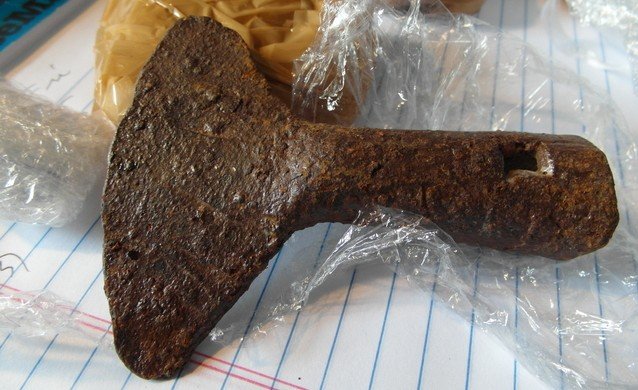
Buddha and Scythians move in with VT
…by Jim W. Dean, VT Editor … with Various Ancient Contributors
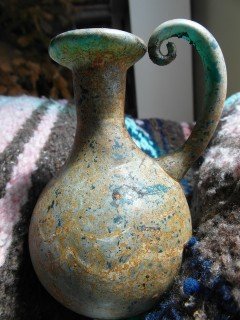
Okay, okay… we have heard you get after us this week a bit. “Where is the mix of Living Section material to break up the diet of hard core stuff that we put on your plates all week?”
Gordon has been busier than usual, as we dealt not only with all the wars, but the new sources who are sick and tired of 9-11, and the security classifications that have hidden what we all really need to know about, i.e. where our most serious threats come from.
But we all have to have lives outside of head-hunting bad guys, even if they are mass murders, which makes treason just one of the lessor felonies they would be charged with.
We will try to get back to some lighter material on the weekends as we need a break from the grind ourselves. I don’t have the animal shelter the Gordon and the Mrs. run at his place, so I am up on deck this weekend.
I will try to get a movie or concert piece up tomorrow, but I thought tonight I wouldcover my expand on my growing family after my earlier piece on my ancient Roman heavily-patinaed glass vase I was able to pick up out of Peking, no less.
Its Han dynasty time period made it a Silk Road import, so it has had a long journey to my house, where I will be a temporary owner of a decade or two in its long journey.
It was in perfect condition as you can see from the arm, and I suspect was buried in a tomb for a long time where most of these old Roman pieces that survived in China were found. They don’t do 2000 years of estate sales and flea markets very well.
But after getting my first piece of 2000 year old glass, I decided to stay in Asia to look for my first major wooden piece — harder to find due to its deterioration rate being much faster than glass. I went looking for some kind of a religious item that would have had special care.
But good luck visited me again in my Buddha find below. It came from Peking in its own styrafoam tomb.
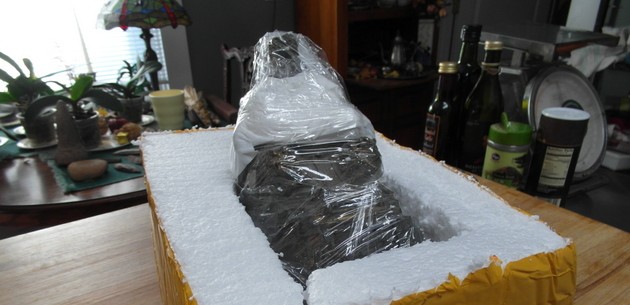
Some very careful unwrapping finally let me take a good look at it. In past years, I had owned a brass (not bronze) one. From the photos I had bought it from, it seemed to be in good shape with just some wear damage around the bottom, and the wood was like prehistoric.
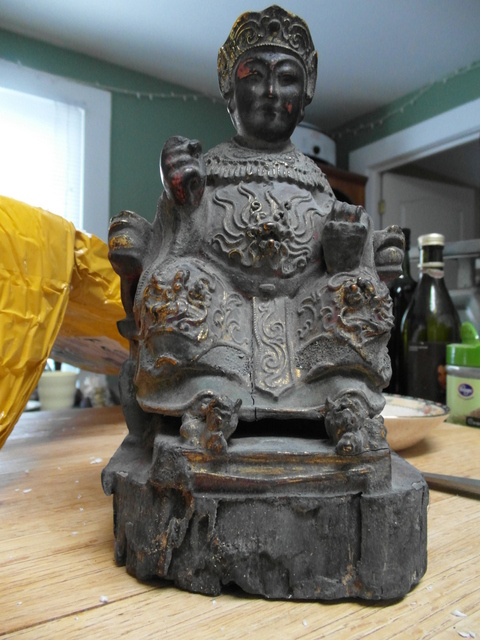
My big thrill this week was getting my very rare ancient Scythian artifacts in, as I had never even run into them before. And to my astonishment, two battle axes were available, so I jumped on those and then filled in (shipping is high, so you need to buy stuff in batches to save there) with some smaller rings, bracelets and a very rare animal talisman, also the first I have ever seen.
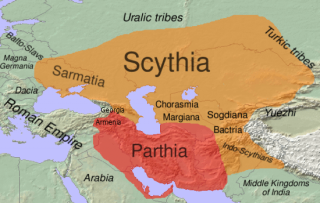
I will let Wikipedia fill us in on who the Scythians were: The Scythians (/ˈsɪθi.ən/ or /ˈsɪði.ən/; from Greek Σκύθης, Σκύθοι) were Iranian equestrian tribes who were mentioned as inhabiting large areas in the central Eurasian steppes, starting with the 7th century BC up until the 4th century AD.
Their territories during the Iron Age were known to classical Greek sources as “Scythia“. Their historical appearance coincided with the rise of equestrian semi-nomadism from the Carpathian Mountains of Europe to Mongolia in the Far East during the 1st millennium BC.
The “classical Scythians” known to ancient Greek historians were located in the northern Black Sea and fore-Caucasus region. Other Scythian groups documented by Near Eastern and Achaemenid sources show that they also existed in Central Asia. Moreover, the term “Scythian” is also used by modern scholars in an archaeological context, i.e. any region perceived to display attributes of the “Scytho-Siberian” culture.
The Scythians were notoriously aggressive warriors. They “fought to live and lived to fight” and “drank the blood of their enemies and used the scalps as napkins” Ruled by small numbers of closely allied élites, Scythians had a reputation for their archers, and many gained employment as mercenaries.
Scythian élites had kurgan tombs: high barrows heaped over chamber-tombs of larch-wood – a deciduous conifer that may have had special significance as a tree of life-renewal, for it stands bare in winter. Burials at Pazyryk in the Altay Mountains have included some spectacularly preserved Scythians of the “Pazyryk culture” – including the Ice Maiden of the 5th century BC.
The Ziwiye hoard, a treasure of gold and silver metalwork and ivory found near the town of Sakiz south of Lake Urmia and dated to between 680 and 625 BC, includes objects with Scythian “animal style” features. One silver dish from this find bears some inscriptions, as yet undeciphered and so possibly representing a form of Scythian writing.
Scythians also had a reputation for the use of barbed and poisoned arrows of several types, for a nomadic life centered on horses – “fed from horse-blood” according to Herodotus – and for skill in guerrilla warfare.
_________________________________
Nomadic warriors have to travel light, so their axe heads were small, not like the Viking bone crushers that came later. A lighter head could be swung much faster, and speed in getting a blow in when an enemy was momentarily exposed was a do or die talent in those days. These were both iron age weapons, so the encrustations come with that, but the broad head one in the top banner was in excellent shape.
They were designed to be fitted onto a tree branch club that had just the right size and right angle limb on it that could hold the axe head at a 90-degree angle. Finding these must have been an industry in itself. You also see at the top banner the squared hole in the base to insert a plug to hold the axehead on tightly, when you would not want it to come loose at a bad time.
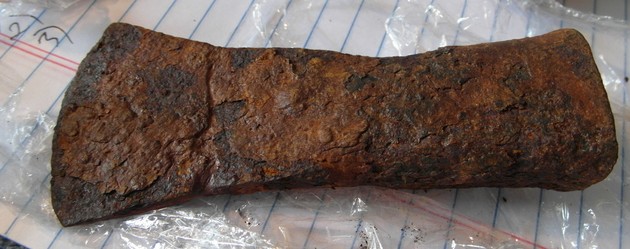
Despite budget concerns, I grabbed the traditional straighter-edged one above, despite its needing some work. So now I will have to bone up on preserving ancient iron. I am not sure I want to get into the electrolysis and wax treatment processing, but I am ordering the basic tools to work on cleaning the caked stuff to see how it looks then.
And yes, I may have to look up some N. Georgia Cherokees to help me find the right type and size branch wood to mount this on for display.
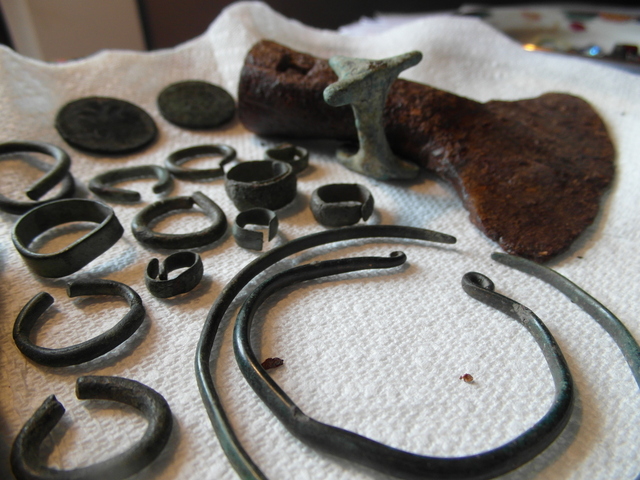
With the two axes, I got both bronze bracelets because they were in excellent shape for their 2500-year age. The smaller one, a children’s size with the curled ends, was more than twice the cost of the larger. The rings are all later Viking ones, a dozen batch, for kids and adults. I wanted a batch to be able to test some different restoration procedures, and these simple folk, non fancy ones are perfect for that.
The last surprise was the deer head talisman, which had broken off in antiquity. I have never seen one for sale among the usual artifact dealers. As the tribes depended on the animal herds of the steppes for food and skins, the deer were an important part of their life, and maybe praying for the herd to not shift their migration paths something that was high on their list.
The battle Axes were of known Scythian style. Items like jewelry, if you do not know for sure where exactly something was found, can be tricky to do a 100% ID with, as this area during this period had Greek, Macedonian and Scythian habitation or war campaigns. Trade goods can also be found far from where they were made.
The two coins in the back were impluse buys, some inexpensive and in decent shape 1700’s Russian ones. I am getting more than I need to eventually open an store to justify the time spent and to recycle some of the expense. It is very easy to slip into wanting a few items for here, and a few from there.
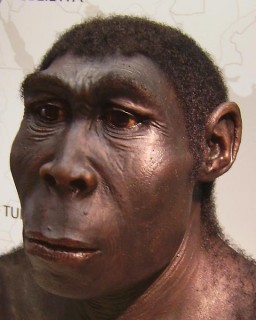
This all came about from getting my DNA test done and wanting to pick up a few physical items from the ancient migration paths out of Africa. I started with some Neanderthal-age stone tools from North Africa, and worked my way back to the Aterian age, 40 to 80K back, and then into the Paleolithic multiple levels.
I had no idea when I started, but I have samples now from the various Acheulean levels, 250K, 500K and even one in the million-year range. It is more than a bit weird holding these things that early prehumans used, none of whose branches survived, a reminder of the fickle fate of the ice ages, competitive evolution scales, and now the NeoCons and the Israeli Lobby to deal with.
The earliest recorded user of stone tools was Homo habilis, 2.3 million years ago, with the Oldowan tool technology, starting with sheared river stones that had an edge that could be used for digging roots and breaking bones to get at bone marrow.
One of my first shocks was learning that early pre-humans were scavengers who would wait for carnivores to leave a kill and then get what they could from it. Home Erectus came a million years later, a slow process, but double the cranial capacity, which lead to advances in tool-making with the bi-faced Acheulean handaxes.
And skipping to the Aerian culture of N. Africa, who brought us the bow and arrow, the bow one level of advancement, but betting the three feathers on the back end of an arrow, along with all the rest of it, was a tremendous achivement, by the Einsteins of the day.
North Africa was grasslands and well-watered during much of that time, with the grazing herds and the bird migrations, which provided a lot of protein for a talented bow man. Below are the two anchors for my stone tool collection.
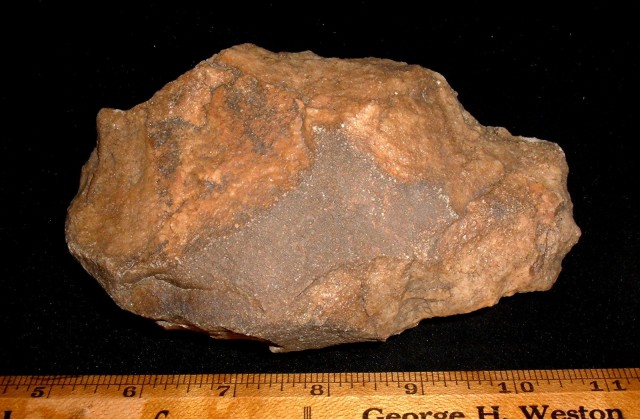
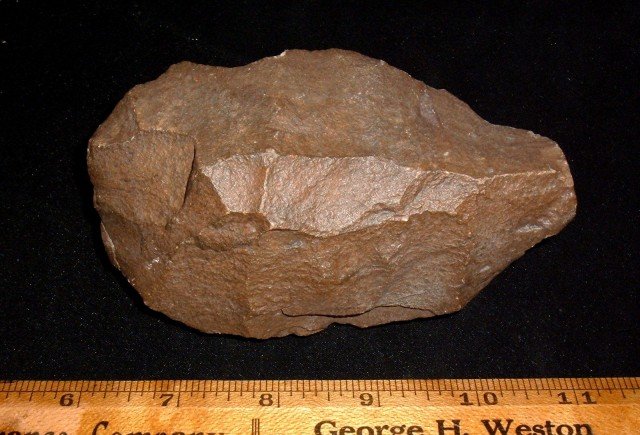
_______________________________

Jim W. Dean was an active editor on VT from 2010-2022. He was involved in operations, development, and writing, plus an active schedule of TV and radio interviews.
ATTENTION READERS
We See The World From All Sides and Want YOU To Be Fully InformedIn fact, intentional disinformation is a disgraceful scourge in media today. So to assuage any possible errant incorrect information posted herein, we strongly encourage you to seek corroboration from other non-VT sources before forming an educated opinion.
About VT - Policies & Disclosures - Comment Policy



